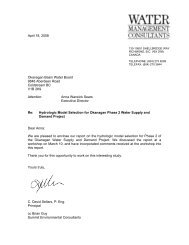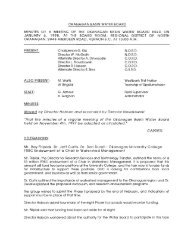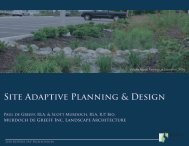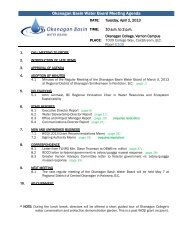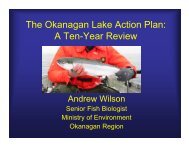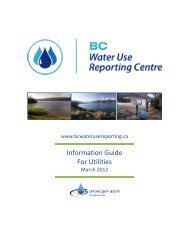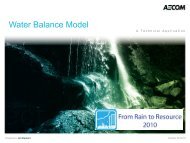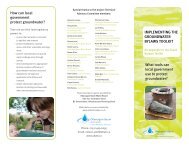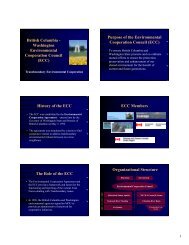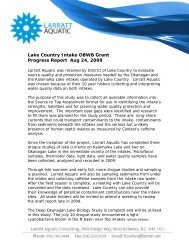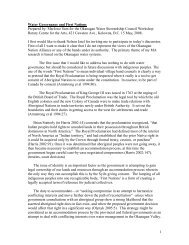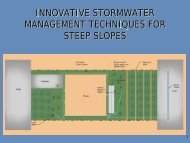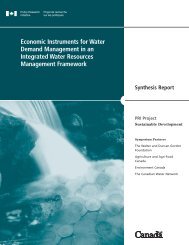Instream Flow Needs Analysis - Okanagan Basin Water Board
Instream Flow Needs Analysis - Okanagan Basin Water Board
Instream Flow Needs Analysis - Okanagan Basin Water Board
- No tags were found...
Create successful ePaper yourself
Turn your PDF publications into a flip-book with our unique Google optimized e-Paper software.
FINAL<strong>Okanagan</strong> <strong>Basin</strong> <strong>Instream</strong> <strong>Flow</strong> <strong>Needs</strong>flow. The intent of watershed conservation flows is to leave sufficient water in the streams during thehigh flow months to fulfill geomorphic needs and promote broader ecological functions. Greater detail onthe BCIFN approach and validation of a modified version that we developed for use with the <strong>Okanagan</strong>naturalized flows is provided in section 2.5.Residual nodes in the <strong>Okanagan</strong> basin are areas that are considered most likely to be fishless. However,the <strong>Instream</strong> <strong>Flow</strong> Technical Committee advised that if a residual node is known to possess a smallpermanent flowing stream(s), then we would assume there are some fish present at the residual node (i.e.,we will assume that all permanent streams in the <strong>Okanagan</strong> are likely to at least have rainbow trout orkokanee present at some point in time). Phil Epp of the Environmental Stewardship Division (MOE) hasidentified a subset of the residual areas (see residual nodes identified in Table 2.2 and Appendix A) thathave permanent flowing streams and could be considered potentially fish-bearing. For these residual areas(4 in total) we have also provided IFN recommendations. A practical issue that limits the application ofour IFN methods in these residual areas is that naturalized flows cannot be made node specific, butinstead must be generalized to the whole residual area. As such our recommended IFN flows must also begeneralized to the entire residual area of interest.Method 3Method 3 is represented by information from site-specific flow studies that have been undertaken in the<strong>Okanagan</strong> <strong>Basin</strong>, which will vary based on the analytical approach used at the node. The subset of nodesfrom which site-specific information is currently available include the <strong>Okanagan</strong> River mainstem, TroutCreek and Mission Creek. <strong>Flow</strong> needs for the <strong>Okanagan</strong> River mainstem are derived from rules developedwithin the <strong>Okanagan</strong> Fish <strong>Water</strong> Management Tool (Alexander and Hyatt 2008). Trout Creek hasestablished a <strong>Water</strong> Use Plan Operating Agreement (as of March 2005) in which required flows are basedon a multiplier of real-time monitored flows at Camp Creek, which acts as a surrogate for a naturalizedhydrograph in Trout Ck. Mission Creek also has a (draft) <strong>Water</strong> Use Plan that will similarly use amultiplier of real-time flows at a surrogate stream (Pearson Creek in this case) for determining requiredflows at Mission Creek (Phil Epp, pers. comm.).2.4 Method 1: Meta-analysis of western North American PHABSIM studiesOne of the most widely used detailed methods for determining instream flow needs is the instream flowincremental methodology (IFIM), developed in the 1970s by physical and biological scientists in the U.S.Fish and Wildlife Service. Accepted by many resource managers as an excellent tool for establishinghabitat-flow relationships, it is the most widely used method in the United States (Reiser et al. 1989;Locke et al. 2008) and is commonly used in the rest of the world.A major component of IFIM is a collection of computer models called the physical habitat simulationmodel (PHABSIM), which incorporates hydrology, stream morphology, and microhabitat preferences togenerate relationships between river flow and habitat availability (Bovee 1982). Habitat availability ismeasured by an index called the weighted useable area (WUA), which is the wetted area of a streamweighted by its suitability for use by an organism. PHABSIM allows habitat–flow relationships to bedeveloped for any life stage of any species and allows quantitative habitat comparisons at different(hypothetical) flows. Typically, PHABSIM produces bell-shaped habitat–flow curves (Figure 2.2). Sucha curve indicates a single flow that maximizes WUA.ESSA Technologies Ltd. & 14Solander Ecological Research



